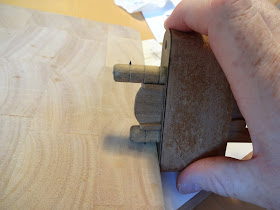I haven't been able to get in the shop all that much lately. Funny how that works.
It's not that I'm not motivated, or in-between projects or something. I am dying to get this freaking Shaker side table finished up. It is still waiting for me to finish mortising the legs.
Life goes on, and often time in involves things that have nothing to do with woodworking. It would be nice to have a nice, normal job with stable hours, but since I don't, I will take shop time as I get it.
Instead, I have been hanging out online surfing eBay with a new friend with similar interests.
Actually, he has been a bad influence, as before we started looking, I didn't think I needed any more tools.
Over the last couple weeks I got an 8mm gimlet bit for my brace, and an awesome French tapered-hole reamer that might be suitable for escapements on rabbet planes (assuming I ever get to start a new project in the shop).
I also got a nice looking pair of snipe's bill moulding planes from the UK and a beautiful looking 18th century British moulding plane (an ogee, I think).
Oh, and in a few minutes I expect to be the owner of a whole collection of gimlet bits. I didn't know they came in different sizes.
Pictures will be forthcoming as soon as this stuff arrives.
There are advantages to living in Germany. Tools on German eBay can be low, if you find something worth buying. The real old tool heaven, though, is in the UK.
Comparing prices from US eBay and the UK flavour is amazing. Certain things are priced high in the US, while super cheap there.
That is, if they will ship out of the country.
I missed out on a pristine Stanley type 11 #4 with an aftermarket blade and chipbreaker for twenty pounds. Infill shoulder planes abound, three for a dollar (practically). Stanley 45s NIB with all the cutters and attachments can be had for less than thirty pounds.
It is weird that most of these sellers won't ship out of the country, because prices for some of these items are through the roof in the US.
There are a few, though. So, I am on the hunt for a new plow plane. Or, should I say, a plough.
I have a Veritas small plow plane with the tongue and groove and wide blade attachments (still in the box - I am a sucker for introductory prices). I like this plane, but it is kind of small. I also think that vintage plow plane blades look awesome. They are nice and thick, and I imagine in a plane that works right will feel a lot better. My plan is to sell the Veritas once I get a suitable replacement.
Plough planes abound on British eBay. The problem, at least for me, is that you are really taking a gamble when buying a used tool from an auction where the seller knows nothing about these tools except how nice they would look nailed to the wall in your dining room.
Plus, blades for plow planes aren't necessarily interchangeable. Almost all reasonably priced (sub-50 pound) plow planes have only the blade that is mounted in the tool, if that. Getting matching irons for your new plane might be a challenge, indeed.
A used tool at a flea market is a great find. However I feel the trick of these markets is to be open and flexible with what tools present themselves. Good deals can be had, but for what you won't know until you get there. It is possible I could find a suitable plow plane at one here in Germany, but I could wind up waiting 350 years for it to present itself. Or, I might find three next weekend. You can't count on it.
There are other options. Plough planes in basket-case shape can be had for as little as 99 cents. I could get one of these and rehab it, or build a new one from scratch using it as a model.
It is also worth sending a note to my favorite old-tool resellers like Joshua Clark, Patrick Leach or Sanford Moss to inquire if they happen to have a decent user for sale. This has the enormous advantage that these sellers will tell you in woodworker lingo about the plane, and it's functionality and/or collect-ability. They also will likely match the plane with irons that actually work on your new plane, saving you the trial-and-error method of getting good fitting irons from eBay.
Whenever I buy a tool from one of these guys, I have absolutely no problem paying four or five times more for these tools than would be my limit on eBay. Knowing exactly what is going to show up in the mail is worth it, to me.
For now I have nothing but time. I have a theory about online auctions: what you want will show up for how much you want to pay, sooner or later. Just don't miss the opportunity when it presents itself.
Oh, also never (I mean NEVER) bid one cent higher than what it is you want to pay. Don't worry, another one will come along sooner or later. If you are raising your own bid, you didn't bid correctly in the first place. And you'll feel like a sucker. Don't ask me how I know this.










































